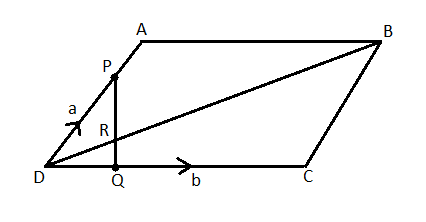
The parallelogram ABCD shows the points P and Q dividing each of the line AD and DC in the ratio 1:4. What is the ratio in which R divides DB? What is the ratio in which R divides PQ?


Answer
540.6k+ views
Hint: First construct the line AQ parallel to PQ. Using similar triangles DPQ and DAQ. There are many types of theorems like cevian theorem to get the ratio of the DB and PQ which pass through R.
Complete step by step answer:
Let $\left| {ABC} \right|$ denote area of $\vartriangle ABC$
Let $\left| {ABCD} \right| = 10x$,
$ \Rightarrow \left| {ABC} \right| = \left| {ADC} \right| = \left| {ABD} \right| = \left| {CBD} \right| = \dfrac{{10x}}{2} = 5x$
Given, $DQ:QC = 1:4$,
$ \Rightarrow \left| {ADQ} \right|:\left| {AQC} \right| = \left| {BDQ} \right|\left| {BQC} \right| = 1:4$,
$ \Rightarrow \left| {ABP} \right| = x,\left| {PBD} \right| = 4x$,
And, $\left| {AQP} \right| = \dfrac{1}{5}x,\left| {PQD} \right| = \dfrac{4}{5}x$
$\left| {PDQB} \right| = \left| {PBD} \right| + \left| {BDQ} \right| = 4x + x = 5x$
$ \Rightarrow \left| {PQB} \right| = \left| {PDQB} \right| - \left| {PDQ} \right| = 5x - \dfrac{4}{5}x = \dfrac{{21}}{5}x$
$ \Rightarrow DR:RB = \left| {PDQ} \right|:\left| {PQB} \right| = \dfrac{4}{5}x:\dfrac{{21}}{5}x = 4:21$
$\therefore PR:RQ = \left| {BPD} \right|:\left| {BDQ} \right| = 4x:x = 4:1$
Note: One may note that there are certain quadrilaterals whose diagonals bisect each other but here we have assumed the quadrilateral as a parallelogram because this is the basic property of a parallelogram.
Complete step by step answer:
Let $\left| {ABC} \right|$ denote area of $\vartriangle ABC$
Let $\left| {ABCD} \right| = 10x$,
$ \Rightarrow \left| {ABC} \right| = \left| {ADC} \right| = \left| {ABD} \right| = \left| {CBD} \right| = \dfrac{{10x}}{2} = 5x$
Given, $DQ:QC = 1:4$,
$ \Rightarrow \left| {ADQ} \right|:\left| {AQC} \right| = \left| {BDQ} \right|\left| {BQC} \right| = 1:4$,
$ \Rightarrow \left| {ABP} \right| = x,\left| {PBD} \right| = 4x$,
And, $\left| {AQP} \right| = \dfrac{1}{5}x,\left| {PQD} \right| = \dfrac{4}{5}x$
$\left| {PDQB} \right| = \left| {PBD} \right| + \left| {BDQ} \right| = 4x + x = 5x$
$ \Rightarrow \left| {PQB} \right| = \left| {PDQB} \right| - \left| {PDQ} \right| = 5x - \dfrac{4}{5}x = \dfrac{{21}}{5}x$
$ \Rightarrow DR:RB = \left| {PDQ} \right|:\left| {PQB} \right| = \dfrac{4}{5}x:\dfrac{{21}}{5}x = 4:21$
$\therefore PR:RQ = \left| {BPD} \right|:\left| {BDQ} \right| = 4x:x = 4:1$
Note: One may note that there are certain quadrilaterals whose diagonals bisect each other but here we have assumed the quadrilateral as a parallelogram because this is the basic property of a parallelogram.
Recently Updated Pages
Master Class 10 General Knowledge: Engaging Questions & Answers for Success

Master Class 10 Computer Science: Engaging Questions & Answers for Success

Master Class 10 English: Engaging Questions & Answers for Success

Master Class 10 Social Science: Engaging Questions & Answers for Success

Master Class 10 Maths: Engaging Questions & Answers for Success

Master Class 10 Science: Engaging Questions & Answers for Success

Trending doubts
The shortest day of the year in India

Why is there a time difference of about 5 hours between class 10 social science CBSE

Write a letter to the principal requesting him to grant class 10 english CBSE

What is the median of the first 10 natural numbers class 10 maths CBSE

The Equation xxx + 2 is Satisfied when x is Equal to Class 10 Maths

Which of the following does not have a fundamental class 10 physics CBSE




